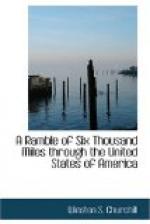The public buildings of Louisville are few, and the streets are laid out in the usual style, crossing each other at right angles. It contains a few good brick dwelling-houses, and a number of excellent hack-carriages are stationed near the steam-boat landing. A canal round the Falls, from Beargrass-creek to Shippingsport, is being constructed, which will enable steam-boats of the largest tonnage to pass through; and thus it will open an uninterrupted intercourse between the Upper and Lower Ohio, and the Mississippi. The length of this canal is about two and a half miles, and the original estimate was 200,000 dollars, but this sum has been found insufficient.
At Louisville I took a berth on board a boat for New Orleans. The steam-boats on the Mississippi are large, and splendidly appointed; the interior has more the appearance of a well fitted up dining-room than the cabin of a boat. The charge is twenty-five dollars, for which you are found in every thing except liquors. Meats, fowls, vegetables, fruits, preserves, &c., are served in abundance, and of the very best quality. Here you may see tradesmen, “nigger traders,” farmers, “congress men,” captains, generals, and judges, all seated at the same table, in true republican simplicity. There is no appearance of awkwardness in the behaviour of the humblest person you see seated at those tables; and indeed their general good conduct is remarkable—I mean when contrasted with that of the same class in England. The truth is, the tradesman here finds himself of some importance in the scale of society, and endeavours to show that he is fully qualified to be seated at the same table, en passant, with the most wealthy citizen. No doubt the higher classes have some of that high polish rubbed off by these occasional contacts with their less-civilized fellow citizens; but the humbler classes decidedly gain what they lose. All dress well, and are American gentlemen.
The Ohio is formed by the junction of the Alleghany and Monongahela rivers at Pittsburg, that town being seated in the fork—its breadth there, is between eight and nine hundred yards. From the mouths of those two rivers it narrows and deepens for some distance; but afterwards, from the accession of the many tributary streams by which it is supplied, gradually becomes wider and deeper, until it empties itself into the Mississippi. The length of the Ohio, following its meanders, is about 950 miles, and it may be said to be navigable almost the entire year, as the water must be unusually low when the smaller steam-boats cannot ply to Pittsburg. The character of this river is somewhat peculiar. But for the improvements on the banks, when you have seen six or eight miles of this stream, you are acquainted with the remainder as far as the Falls—that is to say, any variety that may be in the scenery will occur in any given six miles from Pittsburg to that point. Below Louisville there are one or




